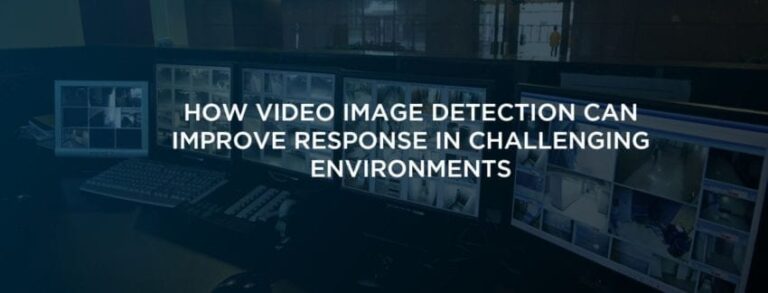By Joshua Dinaburg, PE
Smoke detection has proven a critical tool in saving lives and property. Early warning provides occupants time to safely evacuate and alert firefighters for rapid mobilization. Effective detection also distinguishes fire and smoke from potential false alarms. Advancements in video image detection (VID) provides opportunities to bring early detection of smoke and flame to challenging and high hazard environments. Today, video image smoke detection (VISD) and video image flame detection (VIFD) are increasingly used in critical infrastructures—such as power generation, manufacturing, warehouse and distribution, transport, aircraft hangars, tunnels & prestige buildings—to protect people, property and production.
Challenges for Conventional Smoke Detection Methods
Conventional spot smoke detectors rely on combustion particles to reach a device before alarm activation. Even aspirated smoke detection draws particles from a limited sphere of influence. Spot detection can be limited by ceiling heights, detector spacing, and thermal buoyancy of the source. Smoke must also accumulate sufficient density and penetrate the detection element before activation.
The environment driving the rise and transport of smoke can also impact conventional spot detection methods. For example, smoke stratification can occur when the buoyancy forces lose momentum before reaching detectors at the ceiling. Detectors located above the stratification level will not detect the smoke until fire growth drives the smoke layer higher. Increased fire growth means increased hazard.
For numerous applications, including residential, offices, and commercial spaces conventional spot smoke detection have proven reliable and effective. However, these systems may not provide effective detection for large open spaces. Oftentimes, the cost of installing and maintaining traditional spot detectors in these hard-to-reach locations is difficult, if not impossible. Every facility has its own unique needs and in some cases VID technology might provide more rapid, sensitive, and reliable detection than conventional spot detectors.
How Does Video Smoke and Flame Detection Work?
VID systems first developed in the late 1990s recognize patterns, colors, flickers, and temporal changes in images to identify smoke and/or flames. VID systems can utilize existing standard network security cameras (CCTV) with a central analyzing computer or stand-alone cameras with internal processing and relays can be installed. Images are passed through a series of proprietary algorithms that use different techniques to identify smoke and flame behavior. Depending on field of view, obstructions, movement of smoke, reflections of flames, the VID may not show where it originates. That’s why it is important that both types can relay video to provide control room operators with 24/7 situational awareness. Operators can help eliminate false alarms or locate the exact seat of the fire to improve firefighting tactics.
Advantages of Video Image Detection
In certain applications VID technology can provide rapid detection compared to spot smoke detectors. VID can detect over a broad field of view and are not constrained by issues of smoke transport and layer development. VID detectors can detect smoke or flames within the entire field of view of the camera, which can include very large floor areas and vertical heights. With proper design, they can even operate outdoors to detect flame and smoke plumes. Contrarily, typical smoke detectors are installed with fixed spacing and performance degrades as ceiling heights increase. Video analytics do not require physical contact with smoke. They ‘see’ the danger in the field of view remote from the detector.
In many facilities with large ceiling heights and open floor areas, designers find it impractical to use conventional smoke detection devices because of maintenance and testing challenges; conventional devices generally perform poorly in these environments. Video detection systems can show higher sensitivity to initiating fires and faster response rates than conventional systems—ultimately limiting serious fire incidents and avoiding high damage costs.
How Does VID Fit into Fire Codes?
The National Fire Alarm Code, NFPA 72, recognizes the use of flame and smoke VID systems. The installation of these systems requires a performance-based design. Unless the VID is intended to be supplemental detection, designers need to follow the power requirements of NFPA 72 which means a minimum of 24 hours of standby power. Because of the wide variability of VID system capabilities and the differences in alarm algorithm technologies, NFPA 72 requires that the systems be inspected, tested, and maintained in accordance with the manufacturer’s published instructions. When considering new fire safety system components, it is important to remember that the marketplace will likely move faster than the NFPA Codes can be updated. It is important to consult with experts who can help ensure that the technology you invest in today does not in any way compromise existing fire and life safety regulations.
How Fire Protection Engineers Can Help
Performance-based designs for VID systems must consider a wide range of factors including the camera installation location, ambient lighting and airflow conditions, the facility use, changing conditions over the day and year, the presence of 24/7 monitoring, changing visual obstructions, and the potential locations and sources of ignition Changes in the facility layout or operations can greatly impact the effectiveness of this design. VID can be accidently falsely activated by non-emergency conditions as direct or reflected sunlight, fog, or dust. The conditions may change from winter to summer, or when construction or industrial work is being performed. Qualified fire protection engineers can evaluate your system and develop integrated fire and life system designs, which involve testing and commissioning, to ensure systems perform in conformity with design intent.
Looking ahead
While fire protection designers have successfully applied VID systems in critical infrastructure, there continues to be new applications for these systems including nuclear research facilities and automotive plants. State of the art research into video image classification through machine learning continues to improve the potential of VID devices. As image analysis technologies continue to improve and innovate, these systems have the potential to make smoke and flame detection even more reliable and efficient.
Joshua Dinaburg, PE, is with JENSEN HUGHES
About ARCHEN News
ARCHEN news is a digital media platform for the AEC | MEP | HVAC community.
Interesting project? Send for consideration.
contact@archennews.com or (646) 494-5102





